| History Behind the Wedgewood Inn (on South St. near Madison Ave. in Morristown) |
Below are four Internet articles ... Click here to see map of where this is in Morristown |
New Jersey History's Mysteries |
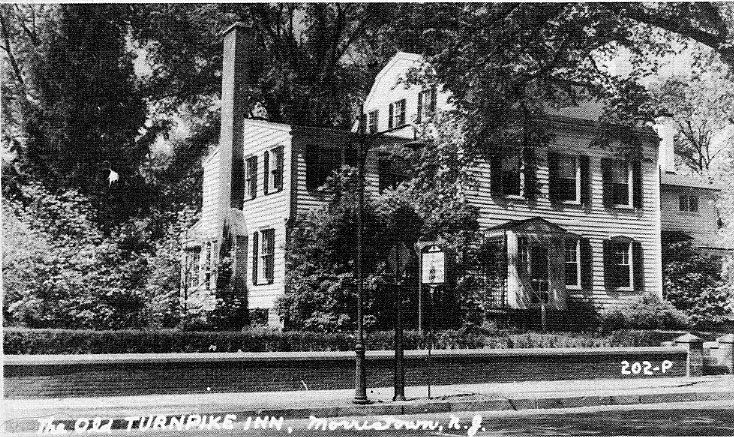
The Haunted Restaurant of Morristown
|
The history of today's Jimmy's Restaurant (actually now a bank) at 217 South Street, in Morristown, New Jersey, serves up some chilling tales besides food and wine.
The original structure was built as a private home back in 1749 by John Sayre. His family and generations thereafter lived in the home without incident.
|
 Many years later, a professor working late in the basement research area of the library of Princeton University discovered
a piece of human skin tucked in to a book with hand written notations describing the fragment as that of Antoine Le Blanc's, 1833. Reta Veader, great-grandmother of the author of this article, had one of the wallets. She would take it out and show it off at family gatherings and such and relay the
horror story behind it. When she passed on, it was left to her daughter, Gladys Smozanek, who donated it to the Morristown Museum. Many years later, a professor working late in the basement research area of the library of Princeton University discovered
a piece of human skin tucked in to a book with hand written notations describing the fragment as that of Antoine Le Blanc's, 1833. Reta Veader, great-grandmother of the author of this article, had one of the wallets. She would take it out and show it off at family gatherings and such and relay the
horror story behind it. When she passed on, it was left to her daughter, Gladys Smozanek, who donated it to the Morristown Museum.
In 1946 the old Sayre House was converted into a restaurant. It suffered a devastating fire in 1957. After the fire, reconstruction included additions and expansion to the building while maintaining the tree that was kept growing through the atrium dining area. Hence the name in the 1970's, the Wedgewood Inn, which was owned by William McCausland. My mother, Ruth Hladik, worked there as a bookkeeper. I would accompany my mother to the restaurant for the day while she worked when I had off from school. I heard the stories about the one room, Phoebe's bedroom, that could never be heated properly (it was usually colder) and how the waitresses working in that room would sometimes see Phoebe's reflection in the mirror and not their own. The shock of this reflection cost the restaurant a fair amount of broken dishes and such, as the waitresses would drop their entire trays when witnessing it. Needless to say, when having to traverse this room to reach the bathroom, I would beeline straight through never even glancing at the mirror. However, I did have time to notice the distinct drop in temperature. Waitresses also reported the feeling of chilling hands being placed on their shoulders but find no one behind them. Mr. McCausland noted the ghostly time he had when his keys disappeared right off his desk. He searched and searched, but could not find them. He returned to his office and had his back to his desk and heard the keys drop. Sure enough, he turned around and there they were right where he had originally left them. When the restaurant changed hands and names (to Society Hill), owner David DeGraff, experienced a paranormal event. The night of the grand opening of Society Hill, a punch bowl was being filled for the party. Suddenly, it cracked and split apart letting the punch pour all over the place. There was no way to explain how a punch bowl could self-destruct in such a way. Over the years, psychics have been brought in to conduct "cleansings" or exorcisms of what they believe are the tormented spirits of Le Blanc and Phoebe. Who's to say if this has worked or not? The restaurant is currently known as Jimmy's. While visiting there this past February, an orb (spirit ball of light) was captured on 35mm film up by the ceiling near the chandelier. Obviously, some otherworldly guest may still be dining there. Author's Note: The tanning of Antoine Le Blanc's skin was not the only ignominy he was forced to endure. After the execution, Dr. Canfield of Morristown took the body, and with the help of the esteemed Dr. Joseph Henry of Princeton University, hooked the corpse up to a primitive battery and passed passed electrical current through it to see if it could be resurrected, endeavoring to prove a prevailing theory at the time which linked electrical current and muscular motor impulses. Although they were able to make the limbs contract, the eyes roll, and the mouth grin, the corpse stayed lifeless. Only after this was the Le Blanc sent to the old Atno Tannery (near today's Morristown High School) to be transformed into such pleasant mementos such as wallets, pouches and book covers. Harry's Note: Atno Avenue, where Harry & Bag rented a house, must have been named after the Atno Tannery. (The author, L'Aura Muller, is the co-founder of the New Jersey Ghost Hunters Society located in Westwood, New Jersey, and has assisted NJHM with her expertise on numerous occasions.) |
Jimmy's Haunt (posted 9/29/2005) |
|
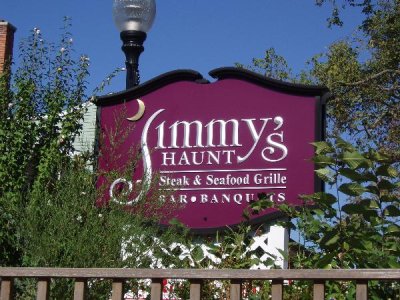 |
 |
| The early history of the Sayre house was peaceful, and it is also where Alexander Hamilton proposed to his love Elizabeth. Then years later in 1833, Judge Samuel Sayre, his wife Sara and a servant girl named Phoebe were murdered.
Antoine Le Blanc, a hired hand decided to rob and loot the Sayres home. One night he murdered the Sayres and Phoebe. He fled to Newark, where he was caught and brought back to Morristown for trial. He was convicted and hanged on the Green in Morristown. His body was delivered
to Arno Tannery to produce morbid Le Blanc human skin souvenirs as wallets, purses, book jackets etc. Some items can be found at the Morristown Museum. Since the incident long ago, supernatural unexplained incidents have occurred in the restaurant. In 1946 the old Sayre House was
converted into the Wincerter Turnpike Inn. In 1957 the Inn suffered a mysterious and devastating fire. In 1960 it was purchased and renamed the Wedgewood Inn, and included a restaurant and Tap room. There is a story about one room, Phoebe's bedroom which is now the upstairs banquet room.
This is where Phoebe was murdered; the room always remained cold even after temperature adjustments. There was always a chill as well as an eerie presence, and waitresses working in that room would sometimes see Phoebe's reflection in the mirror, and one
reported seeing a bloody hand reach out from one of the paintings. Waitresses also reported the feeling of
chilling hands being placed on their shoulders. In addition, after closing for the night, which involved extinguishing candles on the tables, the staff would often look through a window to see a candle or two lit again inside. In 1991 the restaurant changed hands and named Society Hill. The night of the grand opening of Society Hill, the new owners experienced a paranormal event; a punch bowl was being filled for the party. Suddenly, it cracked and split apart
letting the punch pour all over the place. There was no way to explain how a punch bowl could self-destruct in such a way.
Over the years, the old Sayre house has had many different owners, being named South Street, Argyle's Restaurant, Phoebe’s Restaurant and today Jimmy's Haunt. There have been many stories of doors opening, chandeliers swinging, unexplained voices and sounds, and of lights going on in the middle of the night that nobody could even locate the switches for. Psychics have been brought in to conduct paranormal studies of what they believe are the tormented spirits of the Sayres, Phoebe and Le Blanc. |
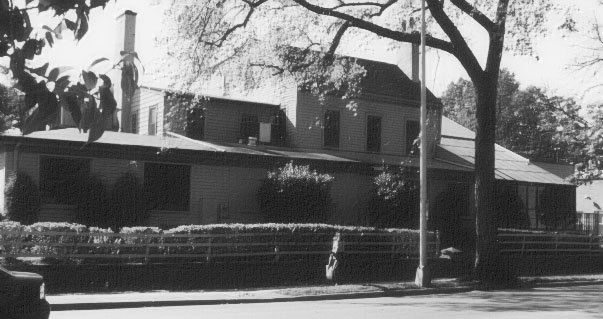 |
Jimmy's Haunt from the back |
A Haunted Bank?
One of the town's oldest buildings, the extraordinary John Sayre House, built in 1749, is the source of a remarkable and macabre legend. In 1833 Judge Samuel Sayre, his wife Sara and their maid (or slave) Phoebe was murdered by Antoine Le Blanc, a recent immigrant from France. Quickly captured and convicted, the hapless Le Blanc was sentenced to be hung and "dissected," thus becoming the last person to be publicly hanged on Morristown's village green currently referred to as "The Green". As if this were not grisly enough, a large number of wallets, purses, lampshades and book jackets were produced from his hair follicle studded hide at the Atno Tannery. Strips of skin were sold on the streets, each one personally signed by the honorable Sheriff Ludlow to verify its authenticity. These grisly little souvenirs reportedly found their way into many a respectable Morristown home, where, it is said, many still remain to this day. As a slave Phoebe was not considered sufficiently important for Le Blanc to be charged and punished for her murder, and according to legend she has continued to haunt the John Sayre house ever since. Having served many functions over the years, the building is now a Commerce Bank which opened up this year. The bank knocked down Jimmy's Haunt, the South Street restaurant that occupied the Sayre House. How that sits with the spirit world remains to be seen. The bizarre tale of "The Wallet-Man" has been featured in Weird NJ. |
Antoine LeBlanc
It was about two weeks after he first started his menial chores on the Sayre farm that Le Blanc decided that he could suffer the indignity no longer. He began to plan his revenge. On the night of May 11, Le Blanc returned to the Sayre house at about 10:30 pm, after drinking at a local tavern. Faking distress, he summoned Samuel Sayre out to the stable, where he said that there was a problem with the horses. Carrying a candle, Mr. Sayre made his way out to the barn, where Le Blanc proceeded to smash in his employer's face with a shovel, splattering pieces of Sayre's brain all over his coat. The killer then repeated his ploy on Mrs. Sayre, finishing her off with a kick to the head from one of his heavy boots. After hiding the two bodies beneath the nearby pile of manure, Le Blanc made his way back to the main house, where he found Phoebe asleep in her bedroom on the second floor. Le Blanc then caved in the unsuspecting girl's skull with a single blow from a club. After his murderous spree, Le Blanc frantically stuffed whatever household valuables he could into pillowcases, donned his dead boss' clothes, stole a horse from the barn, and rode into the night. In his haste to escape the scene of the crime, he unknowingly left a trail of stolen booty in the roadway which would later mark his route. On the morning that followed, Lewis Halsey, a Sayre family friend, discovered some personal effects in the road which bore the monogram of Samuel Sayre. Fearing a robbery had taken place, a group of townsfolk decided to search the Sayre property. After the grisly discovery of the three murdered victims, Sheriff George Ludlow set off in pursuit of the killer. When he caught up with him, Le Blanc was sipping cider in the Mosquito Tavern in the Hackensack Meadows, a pouch of Sayre's possessions by his side. According to his subsequent jail cell confession, Le Blanc had stopped to rest en route to New York, where he planned to board a ship bound for Germany. Upon spotting Sheriff Ludlow, Le Blanc bolted for the back door of the tavern, but was easily apprehended and transported back to Morristown for prosecution. 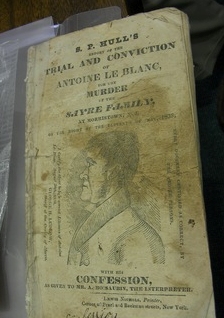 The trial of Antoine Le Blanc, for the murders of the Sayre Family, began in courtroom number one of the Morris County Courthouse on August 13, 1833. After being afforded all the formalities of a fair hearing, a jury took twenty minutes to find the defendant
guilty. The next day, Judge Gabriel Ford handed down the sentence. Le Blanc was to "be hanged by the neck until dead," and then "be delivered to Dr. Isaac Canfield, a surgeon, for dissection." The trial of Antoine Le Blanc, for the murders of the Sayre Family, began in courtroom number one of the Morris County Courthouse on August 13, 1833. After being afforded all the formalities of a fair hearing, a jury took twenty minutes to find the defendant
guilty. The next day, Judge Gabriel Ford handed down the sentence. Le Blanc was to "be hanged by the neck until dead," and then "be delivered to Dr. Isaac Canfield, a surgeon, for dissection."
On the afternoon of September 6th, Le Blanc stood atop the "modern" gallows erected on the village green for the occasion. This new device was designed to jerk the condemned man upward, rather than dropping the floor out from beneath him. A crowd, estimated between 10,000 - 12,000, had descended upon Morristown, greatly outnumbering the local population which was about 2,500 at the time. The jeering mob, many of whom carried bag lunches, made their way into tall trees and onto nearby rooftops to get a better view of the execution. When the counterweight dropped, Le Blanc shot up in the air about eight feet. His body twitched for about two minutes at the end of the rope, and then was still. Just over four months after first setting foot on American soil, Antoine Le Blanc's life was ended. Justice was swifter in those days, with no appeals. The murders occurred in May; the trial, in August; the execution, in September. Near the end, the volatile LeBlanc confessed all to an interpreter. His victims are buried in the Presbyterian Church cemetery in Morristown. The final resting place of LeBlanc's dissected corpse -- last unearthed near the courthouse more than a century ago -- remains a mystery. Watch a 9 minute Youtube video about Antoine LeBlanc. It's at the very bottom of the page. It's also very good. |
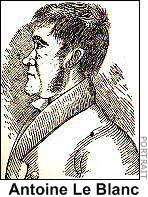 In 1833, Samuel Sayre lived there with his wife, Elizabeth, and a servant girl, Phoebe. An immigrant sailor from the West Indies, Antoine Le Blanc, was hired to help around the farm and house.
However, Le Blanc misunderstood the employment opportunity and thought he would be managing a large operation in the capacity as superintendent. He spoke very little English and as his frustration grew, he decided to make off with what money he thought the Sayres had hidden in their home.
One night he put his plan into action murdering the Sayres by bludgeoning them with a shovel, and their servant girl, Phoebe, with an ax. He made his escape as far as Newark, where a posse caught up with him and brought him back to Morristown for trial. He was convicted and hanged on the
Green in Morristown (the area that today is still centered within the heart of the shopping district).
In 1833, Samuel Sayre lived there with his wife, Elizabeth, and a servant girl, Phoebe. An immigrant sailor from the West Indies, Antoine Le Blanc, was hired to help around the farm and house.
However, Le Blanc misunderstood the employment opportunity and thought he would be managing a large operation in the capacity as superintendent. He spoke very little English and as his frustration grew, he decided to make off with what money he thought the Sayres had hidden in their home.
One night he put his plan into action murdering the Sayres by bludgeoning them with a shovel, and their servant girl, Phoebe, with an ax. He made his escape as far as Newark, where a posse caught up with him and brought him back to Morristown for trial. He was convicted and hanged on the
Green in Morristown (the area that today is still centered within the heart of the shopping district).